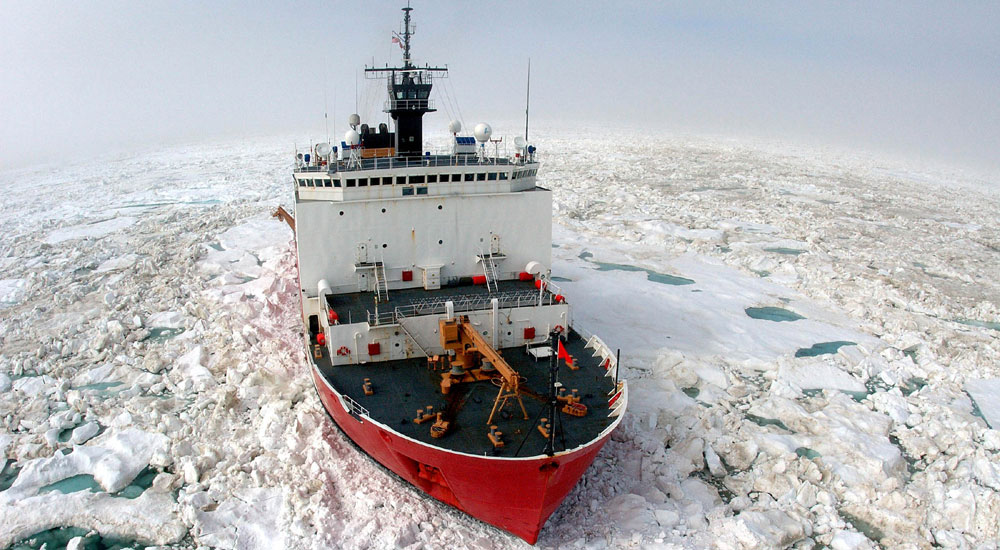
This July 22, 2006, file photo shows the Coast Guard Cutter Healy breaking ice in the Arctic Ocean near Barrow, Alaska. A 200-page report by the National Academy of Sciences says abrupt changes like melting ice in the Arctic Ocean and mass species extinctions have already started and are worse than predicted. AP
WASHINGTON—Hard-to-predict sudden changes to Earth’s environment are more worrisome than climate change’s bigger but more gradual impacts, a panel of scientists advising the US government concluded Tuesday.
The 200-page report by the National Academy of Sciences looked at warming problems that can occur in years instead of centuries. The report repeatedly warns of potential “tipping points” where the climate passes thresholds, beyond which “major and rapid changes occur.” And some of these quick changes are happening now, said study chairman James White of the University of Colorado.
The report says abrupt changes like melting ice in the Arctic Ocean and mass species extinctions have already started and are worse than predicted. It says thousands of species are changing their ranges, seasonal patterns or in some cases are going extinct because of human-caused climate change. Species in danger include some coral; pika, a rabbitlike creature; the Hawaiian silversword plant; and polar bears.
At the bottom of the world in Antarctica, the melting ice in the west could be more of a wild card than originally thought. If the massive ice sheet melts it may happen relatively rapidly and could raise world sea levels by 13 feet, but researchers aren’t certain how soon that may occur.
However, the report had what researchers called “good news.” It said two other abrupt climate threats that worried researchers likely won’t be so sudden, giving people more time to prepare and adapt. Those two less-imminent threats are giant burps of undersea and frozen methane, a super-potent greenhouse gas, and the slowing of deep ocean currents. That slowdown is a scenario that would oddly lead to dramatic coastal cooling and was featured in the 2004 movie “The Day After Tomorrow.”
Study co-author Richard Alley of Pennsylvania State University compared the threat of abrupt climate change effects to the random danger of drunk drivers.
“You can’t see it coming, so you can’t prepare for it. The faster it is, the less you see it coming, the more it costs,” Alley told The Associated Press. “If you see the drunk driver coming, you can get out of the way.”
The scientists said the issue of sudden changes is full of uncertainties, so the world can better prepare by monitoring places like Antarctic and Greenland ice sheets more. But because of budget cuts and aging satellites, researchers have fewer measurements of these crucial indicators than they did a few years ago and will have even fewer in upcoming years, study co-author Steven Wofsy of Harvard University said.
Create an early warning system
The panel called on the government to create an early warning system.
“The time is here to be serious about the threat of tipping points so as to better anticipate and prepare ourselves for the inevitable surprises,” said the report by the research arm of the federal government, which enlists independent scientists to look at major issues.
Donald Wuebbles, a University of Illinois climate scientist who wasn’t part of the academy study, called it important, especially the call for better warning systems. However, outside scientist Michael Mann of Penn State said he doesn’t see the need for a new warning system.
“The warning is already there, loud and clear,” Mann said in an e-mail. “The changes we are seeing in the Arctic are unprecedented in thousands of years, and they are already having a catastrophic impact on human civilizations, animals, and ecosystems there.”
In a separate study, published Tuesday in the journal PLoS One, former NASA climate scientist-turned-activist James Hansen argues that the countries of the world have set the wrong goal in its fight against global warming. World leaders have set a goal of trying to keep warming to another 2 degrees Fahrenheit from now but Hansen said that would blow past tipping points and give Earth a “dangerous level” of global warming.—Seth Borenstein
RELATED STORIES:
Warming report sees violent, sicker, poorer future
Scientists 95%—not 100%—certain global warming is real

